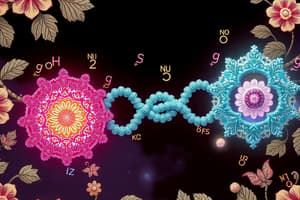Podcast
Questions and Answers
What is indicated by a small Km value in enzyme kinetics?
What is indicated by a small Km value in enzyme kinetics?
- No interaction between enzyme and substrate
- Increased substrate concentration needed for saturation
- Low enzyme affinity for substrate
- High enzyme affinity for substrate (correct)
How does competitive inhibition affect the Michaelis-Menten kinetics of an enzyme?
How does competitive inhibition affect the Michaelis-Menten kinetics of an enzyme?
- It decreases Km but has no effect on Vmax
- It decreases both Vmax and Km
- It has no effect on Vmax but increases Km (correct)
- It increases Vmax and Km
In non-competitive inhibition, which statement is true regarding Vmax and Km?
In non-competitive inhibition, which statement is true regarding Vmax and Km?
- Both Vmax and Km are unaffected
- Vmax is unaffected and Km is decreased
- Vmax is decreased and Km remains the same (correct)
- Vmax is decreased and Km is increased
What is the primary reason competitive inhibitors can be displaced by high substrate concentrations?
What is the primary reason competitive inhibitors can be displaced by high substrate concentrations?
Which statement about the Lineweaver-Burk plot is correct?
Which statement about the Lineweaver-Burk plot is correct?
Which enzyme is classified as a functional plasma enzyme involved in blood clotting?
Which enzyme is classified as a functional plasma enzyme involved in blood clotting?
What is the role of Km in enzyme kinetics?
What is the role of Km in enzyme kinetics?
Which of the following enzymes would likely increase in blood due to tissue damage?
Which of the following enzymes would likely increase in blood due to tissue damage?
What shape does the curve representing reaction velocity against substrate concentration take in Michaelis-Menten kinetics?
What shape does the curve representing reaction velocity against substrate concentration take in Michaelis-Menten kinetics?
The initial velocity (vi) of an enzymatic reaction is affected by which factors?
The initial velocity (vi) of an enzymatic reaction is affected by which factors?
Which statement correctly describes the Lock and Key Theory?
Which statement correctly describes the Lock and Key Theory?
What role does the allosteric site play in enzyme function?
What role does the allosteric site play in enzyme function?
Which type of enzyme is specifically responsible for catalyzing hydrolysis reactions?
Which type of enzyme is specifically responsible for catalyzing hydrolysis reactions?
Which of the following correctly defines isoenzymes or isozymes?
Which of the following correctly defines isoenzymes or isozymes?
Which of the following enzymes is classified as a transferase?
Which of the following enzymes is classified as a transferase?
What distinguishes ligases from other types of enzymes?
What distinguishes ligases from other types of enzymes?
Which is an example of an enzyme that acts as a lyase?
Which is an example of an enzyme that acts as a lyase?
How many isoenzymes does lactate dehydrogenase exist as?
How many isoenzymes does lactate dehydrogenase exist as?
What distinguishes uncompetitive inhibitors from noncompetitive inhibitors?
What distinguishes uncompetitive inhibitors from noncompetitive inhibitors?
What is the effect of uncompetitive inhibitors on Vmax compared to Km?
What is the effect of uncompetitive inhibitors on Vmax compared to Km?
Which of the following is NOT a mechanism of long-term regulation of enzyme activity?
Which of the following is NOT a mechanism of long-term regulation of enzyme activity?
How does enzyme synthesis affect long-term regulation of enzymes?
How does enzyme synthesis affect long-term regulation of enzymes?
Which statement accurately describes the binding characteristics of uncompetitive inhibitors?
Which statement accurately describes the binding characteristics of uncompetitive inhibitors?
Which regulation method involves post-translational modifications affecting enzyme function?
Which regulation method involves post-translational modifications affecting enzyme function?
What is an effect of competitive inhibition on enzyme kinetics?
What is an effect of competitive inhibition on enzyme kinetics?
In terms of regulation, what is the primary distinction between short-term and long-term regulation?
In terms of regulation, what is the primary distinction between short-term and long-term regulation?
What is the primary function of an inducer in enzyme synthesis?
What is the primary function of an inducer in enzyme synthesis?
What are the effects of allosteric modulators on enzyme activity?
What are the effects of allosteric modulators on enzyme activity?
How does feedback inhibition function within a metabolic pathway?
How does feedback inhibition function within a metabolic pathway?
What role does phosphorylation play in enzyme regulation?
What role does phosphorylation play in enzyme regulation?
What is a common characteristic of repressors in enzyme synthesis?
What is a common characteristic of repressors in enzyme synthesis?
What differentiates a synthetase from a synthase in enzyme nomenclature?
What differentiates a synthetase from a synthase in enzyme nomenclature?
Which of the following best describes reversible covalent modification?
Which of the following best describes reversible covalent modification?
What is the activity of kinases and phosphatases primarily regulated by?
What is the activity of kinases and phosphatases primarily regulated by?
Flashcards are hidden until you start studying
Study Notes
Enzyme Action Models
- Lock and Key Theory: Enzyme and substrate fit perfectly together like a key in a lock. Explains enzyme specificity and loss of activity during denaturation.
- Induced Fit Model: Enzyme and substrate change shape to accommodate each other. Interaction between substrate and enzyme induces conformational changes in the enzyme to create a complementary binding site. Explains enzymes reacting with a range of similar substrates.
Enzyme Active Sites
- Catalytic Site: Main binding site for the substrate.
- Allosteric Site: Specific site on the enzyme away from the catalytic site that binds effectors to either stimulate or inhibit reactions.
Classification of Enzymatic Reactions
- Oxidoreductases: Catalyze oxidation-reduction reactions.
- Transferases: Catalyze the transfer of groups other than hydrogen between substances (e.g., kinases).
- Hydrolases: Catalyze hydrolysis, breaking down bonds with the addition of water (e.g., lipases).
- Lyases: Catalyze simple splitting of substrates without adding water (e.g., decarboxylases, which remove CO2).
- Ligases: Join molecules together using ATP as an energy source (e.g., synthetases).
- Isomerases: Catalyze the interconversion of isomers (e.g., phosphohexose isomerase). Includes epimerases and mutases.
Isoenzymes/Isozymes
- Different forms of the same enzyme catalyzing the same reaction using the same coenzyme and substrate.
- Have different:
- Km & Vmax values
- Physical properties
- Immunological reactions
- Example: Lactate dehydrogenase (LDH) is a tetrameric protein with two types of subunits (H and M) and exists as 5 different isoenzymes with various subunit combinations. LDH-I is elevated in myocardial infarction.
- Creatine Kinase (CK): A dimer with two subunits (B and M) and exists in three isoenzymes: CK-BB increases in brain infarction, CK-MB increases in myocardial infarction, and CK-MM increases in muscle diseases.
Plasma Enzymes
- Functional Plasma Enzymes: Normally present in blood for physiological functions (e.g., blood clotting proenzymes like prothrombin, lipoprotein lipase, pseudocholine esterase).
- Non-functional Plasma Enzymes: Produced and act inside cells, present in low concentrations in blood, and increase in blood with tissue damage (e.g., liver transaminases (ALT & AST), pancreatic amylase and lipase, alkaline phosphatase & acid phosphatase, lactate dehydrogenase (LDH), creatine phosphokinase (CPK)).
Enzyme Kinetics
- Reaction Rate: Change in reactant or product concentration per unit time.
- Initial Velocity (Vi): Velocity measured when only a small amount of substrate has reacted. Dependent on both substrate and enzyme concentration.
- Maximum Velocity (Vmax): Velocity reached when all enzyme molecules are saturated with substrate.
- Michaelis-Menten Kinetics: Describes how reaction velocity varies with substrate concentration. Represented by a hyperbolic curve on a graph.
- Km (Michaelis Constant): Substrate concentration at which half the maximum velocity (½ Vmax) is achieved. Reflects affinity between enzyme and substrate.
- Small Km: High affinity
- Large Km: Low affinity
- Lineweaver-Burk Plot: A linearized version of the Michaelis-Menten equation, useful for determining the effects of drugs on enzymes.
Enzyme Inhibition
- Competitive Inhibition: Inhibitor structurally similar to substrate and binds to the same active site, increasing Km but not affecting Vmax. Can be reversible or irreversible.
- Non-competitive Inhibition: Inhibitor doesn't resemble the substrate and binds to a different site on the enzyme. Decreases Vmax but does not affect Km.
- Uncompetitive Inhibition: Inhibitor binds only to the enzyme-substrate complex, decreasing both Km and Vmax.
Enzyme Regulation
- Long-Term Regulation: Regulation of enzyme quantity (synthesis and degradation) and takes hours or days.
- Synthesis: Controlled by induction (increased synthesis triggered by inducers) or repression (inhibition of synthesis by repressors).
- Degradation: Involves the hydrolysis of the enzyme.
- Short-Term Regulation: Rapid changes in enzyme activity from inactive to active form (and vice versa).
- Allosteric Regulation: Binders (modulators) at allosteric sites induce conformational changes affecting the enzyme's affinity for the substrate.
- Positive Modulators: Activate the enzyme (e.g., allosteric activators).
- Negative Modulators: Inhibit the enzyme (e.g., allosteric inhibitors).
- Feed-back Inhibition: Inhibition of an enzyme in a metabolic pathway by the end product of that pathway.
- Reversible Covalent Modifications: Phosphorylation/dephosphorylation.
- Kinases: Transfer phosphate groups from ATP to enzyme serine/threonine amino acids.
- Phosphatases: Remove phosphate groups.
- Activity of kinases and phosphatases is under hormonal and neural control (e.g., glucagon causes phosphorylation, insulin causes dephosphorylation).
- Allosteric Regulation: Binders (modulators) at allosteric sites induce conformational changes affecting the enzyme's affinity for the substrate.
Factors Affecting Enzyme Activity
- These factors affect enzyme activity and are often investigated in lab experiments.
- Confusing Nomenclature:
- Synthetase: Requires ATP.
- Synthase: Doesn't require ATP.
- Kinases: Catalyze the transfer of phosphate groups from high-energy molecules to substrates.
Studying That Suits You
Use AI to generate personalized quizzes and flashcards to suit your learning preferences.





